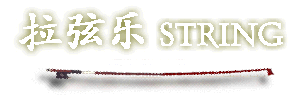
Web Composer: 

City Chinese Orchestra
![]()
Wong Chin Loon
E-mail:
chinloon@pacific.net.sg
Updated:
28 Jun 1997
Feedback, comments
and suggestions
are welcomed.

The Bass Section was the last to be developed in the String Section. It originally consisted of more traditional instruments such as Di Gehu, or Di Ma Tou Qin. However, due to being cumbersome and difficult in mastering the art of performing, Bass are used in most of the modern Chinese Orchestra.
 Di Gehu is a hybrid between Dihu and Bass. It was invented by Yang Yu Ling (1926~1980). The skin used for the wooden drum are python skin, horse skin or lamb skin. It has four strings tuned to perfect fourth (E, A, D, G). It has a fingering board similar to that of a Bass. The bow is detached from the string, which allows easy interchange between bowing and plucking the strings. Yang Yu Ling succeeded in finalising its structure in 1979 after more than 560 experiments on different structures.
Di Gehu is a hybrid between Dihu and Bass. It was invented by Yang Yu Ling (1926~1980). The skin used for the wooden drum are python skin, horse skin or lamb skin. It has four strings tuned to perfect fourth (E, A, D, G). It has a fingering board similar to that of a Bass. The bow is detached from the string, which allows easy interchange between bowing and plucking the strings. Yang Yu Ling succeeded in finalising its structure in 1979 after more than 560 experiments on different structures.
Di Ma Tou Qin is developed from Ma Tou Qin, a Mongolian String Instrument. It is called "Ma Tou" because at the top of the instrument, is a beautifully carved horse head. It is famous for its unique, low and mellow tone. Its structure is one of a trapezium-shaped drum, and a long fingering board which connects the strings from the drum to the wooden pegs below the horse head. There are two wooden pegs and two strings. Art of performing is very difficult to master, especially the fingering of the strings. Index finger tip, middle finger nail, fourth finger tip and the last finger nail are used to vary the tensions of the two strings. This is different from the normal way where all four finger tips are used to press the strings.